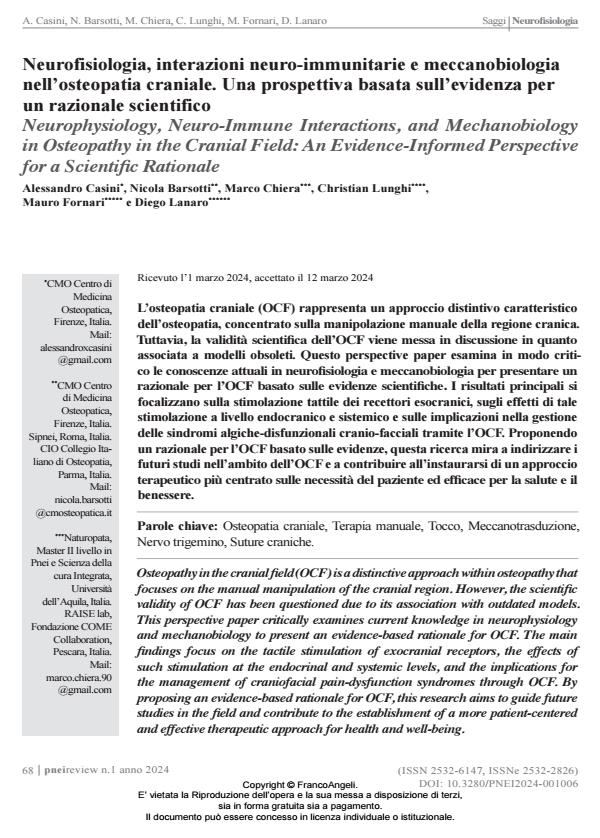Neurophysiology, Neuro-Immune Interactions, and Mechanobiology in Osteopathy in the Cranial Field: An Evidence-Informed Perspective for a Scientifi c Rationale
Journal title PNEI REVIEW
Author/s Alessandro Casini, Nicola Barsotti, Marco Chiera, Christian Lunghi, Mauro Fornari, Diego Lanaro
Publishing Year 2024 Issue 2024/1
Language Italian Pages 14 P. 68-81 File size 1137 KB
DOI 10.3280/PNEI2024-001006
DOI is like a bar code for intellectual property: to have more infomation
click here
Below, you can see the article first page
If you want to buy this article in PDF format, you can do it, following the instructions to buy download credits

FrancoAngeli is member of Publishers International Linking Association, Inc (PILA), a not-for-profit association which run the CrossRef service enabling links to and from online scholarly content.
Osteopathy in the cranial field (OCF) is a distinctive approach within osteopathy that focuses on the manual manipulation of the cranial region. However, the scientific validity of OCF has been questioned due to its association with outdated models. This perspective paper critically examines current knowledge in neurophysiology and mechanobiology to present an evidence-based rationale for OCF. The main findings focus on the tactile stimulation of exocranial receptors, the effects of such stimulation at the endocrinal and systemic levels, and the implications for the management of craniofacial pain-dysfunction syndromes through OCF. By proposing an evidence-based rationale for OCF, this research aims to guide future studies in the field and contribute to the establishment of a more patient-centered and effective therapeutic approach for health and well-being.
Keywords: Osteopathy in the cranial field, Manual therapy, Touch, Mechano- transduction, Trigeminal nerve, Cranial sutures.
Alessandro Casini, Nicola Barsotti, Marco Chiera, Christian Lunghi, Mauro Fornari, Diego Lanaro, Neurofisiologia, interazioni neuro-immunitarie e meccanobiologia nell’osteopatia craniale. Una prospettiva basata sull’evidenza per un razionale scientifico in "PNEI REVIEW" 1/2024, pp 68-81, DOI: 10.3280/PNEI2024-001006